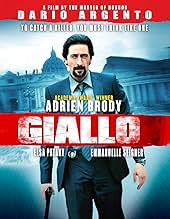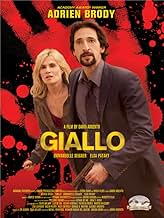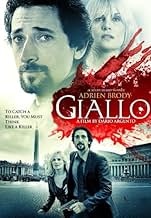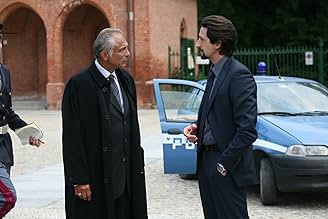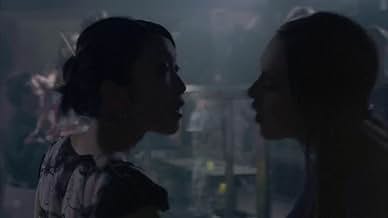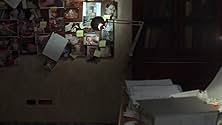AVALIAÇÃO DA IMDb
4,5/10
6,3 mil
SUA AVALIAÇÃO
Adicionar um enredo no seu idiomaIn Italy, a woman fears her sister has been kidnapped; Inspector Enzo Avolfi fears it's worse. They team up to rescue her from a sadistic killer known only as Yellow.In Italy, a woman fears her sister has been kidnapped; Inspector Enzo Avolfi fears it's worse. They team up to rescue her from a sadistic killer known only as Yellow.In Italy, a woman fears her sister has been kidnapped; Inspector Enzo Avolfi fears it's worse. They team up to rescue her from a sadistic killer known only as Yellow.
- Direção
- Roteiristas
- Artistas
- Prêmios
- 1 vitória no total
Adrien Brody
- Inspector Enzo Avolfi
- (as Byron Deidra)
- …
Valentina Izumi
- Keiko
- (as Valentina Izumì)
Giuseppe Loconsole
- Butcher
- (as Giuseppe Lo Console)
- Direção
- Roteiristas
- Elenco e equipe completos
- Produção, bilheteria e muito mais no IMDbPro
Avaliações em destaque
Giallo (2009)
* 1/2 (out of 4)
Looking at the title and seeing Argento's name, you might expect this film to be a giallo but you'd be mistaken. Set in Italy, a woman gets kidnapped by a psychopath killer so her sister (Emmanuelle Seigner) teams up with an Inspector (Adrien Brody) to try and locate her. There's no question that Argento's career has been very hit and miss over the past twenty-years but I've been pretty kind to him finding many of the films to be entertaining for what they are. At the same times he's made some really bad stuff like PHANTOM OF THE OPERA and DO YOU LIKE HITCHCOCK? and while this one here isn't that bad, it's still lower level stuff and it's a shame considering I'm sure many were hoping for a better project. The biggest problem is the screenplay that is downright horrid as it gives us no characters to care for, an idiotic killer and some really lame dialogue. The story jumps around so much that at times it feels as if the movie doesn't know what it's trying to do or what type of story it's trying to tell. The sister characters come across as people we can't really stand so we don't care if they live or die. The Inspector character isn't any better as the screenplay tries to give him some backstory yet it's nothing interesting or deep enough to make us care. Then there's the killer known as "Yellow" because of his skin color. I'm really not sure what they were thinking but it just doesn't work. The film throws in some rather tame death sequences with many of them happening off screen. We do get a few gory shots that are pretty over the top but nothing we haven't seen countless times before. Female characters have never been a strong point in any Argento film and that continues here as I really didn't care for Seigner's character or her performance. Watching Brody here you have to keep pinching yourself that he's an Oscar-winner as he really doesn't come off looking too good. Then we have Argento who must have lost any of his stylish eye because there's very little. All in all, this is a pretty big mess and a real disappointment for me as I was one of the few who really enjoyed his third entry in the Three Mothers series. I do hope he continues to make more films but hopefully they'll turn out better than this.
* 1/2 (out of 4)
Looking at the title and seeing Argento's name, you might expect this film to be a giallo but you'd be mistaken. Set in Italy, a woman gets kidnapped by a psychopath killer so her sister (Emmanuelle Seigner) teams up with an Inspector (Adrien Brody) to try and locate her. There's no question that Argento's career has been very hit and miss over the past twenty-years but I've been pretty kind to him finding many of the films to be entertaining for what they are. At the same times he's made some really bad stuff like PHANTOM OF THE OPERA and DO YOU LIKE HITCHCOCK? and while this one here isn't that bad, it's still lower level stuff and it's a shame considering I'm sure many were hoping for a better project. The biggest problem is the screenplay that is downright horrid as it gives us no characters to care for, an idiotic killer and some really lame dialogue. The story jumps around so much that at times it feels as if the movie doesn't know what it's trying to do or what type of story it's trying to tell. The sister characters come across as people we can't really stand so we don't care if they live or die. The Inspector character isn't any better as the screenplay tries to give him some backstory yet it's nothing interesting or deep enough to make us care. Then there's the killer known as "Yellow" because of his skin color. I'm really not sure what they were thinking but it just doesn't work. The film throws in some rather tame death sequences with many of them happening off screen. We do get a few gory shots that are pretty over the top but nothing we haven't seen countless times before. Female characters have never been a strong point in any Argento film and that continues here as I really didn't care for Seigner's character or her performance. Watching Brody here you have to keep pinching yourself that he's an Oscar-winner as he really doesn't come off looking too good. Then we have Argento who must have lost any of his stylish eye because there's very little. All in all, this is a pretty big mess and a real disappointment for me as I was one of the few who really enjoyed his third entry in the Three Mothers series. I do hope he continues to make more films but hopefully they'll turn out better than this.
The high point in the film comes midway in the form of Adrian Brody's childhood flashback: the camera heaves this side and that inside an amber-lit room as though floating in the air while a music box lullaby that brings back memories of Goblin's School at Night theme from Profondo Rosso chimes in the background. Other than that, the movie might as well have been called "Routine Slasher" because there's nothing that recalls the glorious days of the Italian giallo here, no wink or homage or black-gloved killer stalking distraught heroines in kitsch/chic Rome apartments, countryside villas, and medieval architecture and certainly none of the Technicolor phantasmagoria Argento and his peers conjured on celluloid 30 years ago because anyone who has followed Argento's career knows he has been working in dark muted DV canvases for the past 10 years, this absence of style flooded with wooden acting, bad English from non-English speaking actors, and a script the sum of plot contrivance happenstance and logic jumps. Some will argue these have been staples of Argento's career and I will disagree because their place has always been peripheral to a certain grand guignol aesthetic by whose outrageousness, stylistic or otherwise, not only have they been relegated to the margins but they have made perfect "sense" there in the margins as part of Argento's style (or Italian horror film-making in general). If Mother of Tears was a bold step in the direction of Phenomena's schizophrenic conclusion, this is a step backwards to the undistinguished workmanlike nature of Il Cartaio and Ti Piace Hitchcock. Everything here is generic. The score sounds like Batman Returns throwaways (Claudio Simonetti's absence is sorely felt), the villain is a curious mixture of pathetic and creepy, Argento's stylized violence is conspicuously absent. This is a serial killer movie trying to balance between crime procedural and slasher such as one may find in Lionsgate's STD catalogue. If you're looking for the giallo homage the title promises, you'll find it in Sleepless. This is a routine affair not worthy of the master's name or his fans' time and money.
Many people have compared this film to 2004's Eyes of Crystal, and I have no doubt that Argento was influenced by said film, but one thing I do want to say is that Giallo has much cleaner and more precise cinematography, and that is a huge improvement over Eyes of Crystal's jerky and fast camera movement style. I know that it was popular in the 00's, and even up until only a few years ago, but it's always been a style I've hated.
At any rate, this isn't exactly a great effort from late Argento. A hell of a lot better than Dracula 3D, but what isn't?
Sleepless is much better than this, as is The Stendhal Syndrome and Trauma. Just about the only post-Opera film it does overtake is Phantom of the Opera, and again, what doesn't?
Giallo is honestly somewhat of a disappointment, especially considering the pretty involving beginning.
Visually however, it is somewhat of a treat. And for me, visuals are even more important than plot. What this IS lacking is atmosphere, pacing, and tension- in favour of gore and torture. Not a good trade off.
If a single trait characterizes Dario Argento's 21st century output, it's its self-referentiality. Always a cine-literate filmmaker, his recent material has verged almost on self-parody. Amid all this, a generation of filmmakers have grown up with his films and been influenced by them, some more profoundly than others. Some, like Tim Burton, have assimilated his visual style into their own. Others have been more flippant in their appropriation of Argentoisms, with Quentin Tarantino lifting the music from The Bird with the Crystal Plumage for use in Death Proof, and Diablo Cody including a conversation debating the merits of Argento relative to H.G. Lewis in Juno. In effect, "Argento" has become something of a buzzword for a certain type of movie brat: a slightly edgy (but not too edgy) name they can mention to show that they're a little off the beaten track (but not too far off).
Oddly enough, Giallo represents something of a hybridization of the director's self-referentiality and the sort of fan idolatry that champions his films for their more superficial elements while ignoring the qualities that truly mark them out. Although the first credit at the end of the film reads "written and directed by Dario Argento", the original script in fact originated from two American fans, Jim Agnew and Sean Keller, with Argento essentially being brought on as a director for hire. This is not the first time this has happened: the two episodes he directed for the largely disappointing Masters of Horror series also originated from other writers, much to their detriment. (If Pelts had been directed by Eli Roth, I doubt it would have been appreciably different.) While Giallo's script is nothing remarkable, the overall execution is handled with considerably more flair than Jenifer or Pelts. This may be because Argento is on familiar stomping ground, with the Italian locations lending an air of natural class. Giallo is far from the bland, anonymous piece of work for hire that many feared it would be. While Frederic Fasano's cinematography lacks the verve of a Tovoli or even a Debie, and Marco Werba's Herrmannesque score alternates between effective and intrusive, there are little Argentoisms throughout, mainly in the lightly humorous moments. Likewise, an early sequence at an opera recalls Argento's 1987 masterpiece of the same name, while the oddly ambiguous final frame is reminiscent of The Cat O' Nine Tails.
That said, Giallo's most direct counterpart is The Card Player, and it's tempting to see them as two sides of the same coin. However, while The Card Player was clinical, high-tech and almost bloodless, Giallo goes in the opposite direction. Its set design hearkens back to the past, from Avolfi's dingy basement office to the foregrounding of Turin's picturesque monuments and buildings. The violence is also ramped up a notch, and it's tempting to view the film as Argento's reaction to the recent spate of so-called "torture porn" movies. The director has made conflicting statements as to his opinion of these films, but the lengthy scenes of Elsa Pataky being menaced and tortured in the killer's grimy underground lair are more reminiscent of Saw or Hostel than anything in Argento's past filmography.
And there's the rub: despite being marketed as a return to the genre that made a name for Argento in the 1970s, Giallo... well, isn't actually a giallo. The plot operates more as a cross between a cop thriller and a gore-soaked torture flick, the title referring solely to the killer's jaundiced skin. His face is seen almost from the start and his identity is ultimately not hugely important. Far more interesting is the way in which he and Avolfi are constructed as two sides of the same coin, both pariahs who operate in dark underground lairs and have suffered violent, traumatic pasts. As with much of his past work, Argento seems to be actively encouraging a Jungian reading. At times, this becomes a little too on the nose, with the casting of the killer... well, it's an intriguing choice but ultimately one that will either baffle people or have them slapping their foreheads at its obviousness.
With one notable exception, the cast acquit themselves reasonably well. The elephant in the room is Adrien Brody, who not only receives top billing but also an executive producer credit, performing uncredited script doctoring duties and making key decisions about the score (including nixing Argento's regular collaborator Claudio Simonetti). His role is an odd one, and it's far from the vanity project I expected. Avolfi is not particularly pleasant: he's distant, smarmy and reckless, and an act he committed in the past further blurs the line between him and the killer. Unfortunately, the specifics of this event, revealed around two-third of the way through the film, sent the audience at the screening I attended into fits of hysterics. More problematic in my mind, however, is Brody's performance. He seems to be imitating any number of 40s film noir detectives, but comes across as a mumbling buffoon whose reactions and line delivery always seem to be at odds with what's actually happening. He's not the first Oscar-winning actor to work with Argento, but he IS one of Argento's least convincing protagonists.
Giallo is a decent offering from a director whose work of late has been decidedly patchy. While I'm sure the usual battle lines will be drawn, with fans alternating between branding it a return to form and proclaiming it to be proof that he is a has-been, the truth is somewhere in the middle. No, it's not the next Profondo Rosso, but anyone who expected otherwise would simply be deluding themselves. It's substantially better than either of Argento's Masters of Horror outings, a step up from Mother of Tears, and a superior thriller to Do You Like Hitchcock? It's also more engaging than the overrated Sleepless and about on par with the underrated The Card Player, a film that for me improves with each subsequent viewing. Problems aside, Giallo is surprisingly good fun.
Oddly enough, Giallo represents something of a hybridization of the director's self-referentiality and the sort of fan idolatry that champions his films for their more superficial elements while ignoring the qualities that truly mark them out. Although the first credit at the end of the film reads "written and directed by Dario Argento", the original script in fact originated from two American fans, Jim Agnew and Sean Keller, with Argento essentially being brought on as a director for hire. This is not the first time this has happened: the two episodes he directed for the largely disappointing Masters of Horror series also originated from other writers, much to their detriment. (If Pelts had been directed by Eli Roth, I doubt it would have been appreciably different.) While Giallo's script is nothing remarkable, the overall execution is handled with considerably more flair than Jenifer or Pelts. This may be because Argento is on familiar stomping ground, with the Italian locations lending an air of natural class. Giallo is far from the bland, anonymous piece of work for hire that many feared it would be. While Frederic Fasano's cinematography lacks the verve of a Tovoli or even a Debie, and Marco Werba's Herrmannesque score alternates between effective and intrusive, there are little Argentoisms throughout, mainly in the lightly humorous moments. Likewise, an early sequence at an opera recalls Argento's 1987 masterpiece of the same name, while the oddly ambiguous final frame is reminiscent of The Cat O' Nine Tails.
That said, Giallo's most direct counterpart is The Card Player, and it's tempting to see them as two sides of the same coin. However, while The Card Player was clinical, high-tech and almost bloodless, Giallo goes in the opposite direction. Its set design hearkens back to the past, from Avolfi's dingy basement office to the foregrounding of Turin's picturesque monuments and buildings. The violence is also ramped up a notch, and it's tempting to view the film as Argento's reaction to the recent spate of so-called "torture porn" movies. The director has made conflicting statements as to his opinion of these films, but the lengthy scenes of Elsa Pataky being menaced and tortured in the killer's grimy underground lair are more reminiscent of Saw or Hostel than anything in Argento's past filmography.
And there's the rub: despite being marketed as a return to the genre that made a name for Argento in the 1970s, Giallo... well, isn't actually a giallo. The plot operates more as a cross between a cop thriller and a gore-soaked torture flick, the title referring solely to the killer's jaundiced skin. His face is seen almost from the start and his identity is ultimately not hugely important. Far more interesting is the way in which he and Avolfi are constructed as two sides of the same coin, both pariahs who operate in dark underground lairs and have suffered violent, traumatic pasts. As with much of his past work, Argento seems to be actively encouraging a Jungian reading. At times, this becomes a little too on the nose, with the casting of the killer... well, it's an intriguing choice but ultimately one that will either baffle people or have them slapping their foreheads at its obviousness.
With one notable exception, the cast acquit themselves reasonably well. The elephant in the room is Adrien Brody, who not only receives top billing but also an executive producer credit, performing uncredited script doctoring duties and making key decisions about the score (including nixing Argento's regular collaborator Claudio Simonetti). His role is an odd one, and it's far from the vanity project I expected. Avolfi is not particularly pleasant: he's distant, smarmy and reckless, and an act he committed in the past further blurs the line between him and the killer. Unfortunately, the specifics of this event, revealed around two-third of the way through the film, sent the audience at the screening I attended into fits of hysterics. More problematic in my mind, however, is Brody's performance. He seems to be imitating any number of 40s film noir detectives, but comes across as a mumbling buffoon whose reactions and line delivery always seem to be at odds with what's actually happening. He's not the first Oscar-winning actor to work with Argento, but he IS one of Argento's least convincing protagonists.
Giallo is a decent offering from a director whose work of late has been decidedly patchy. While I'm sure the usual battle lines will be drawn, with fans alternating between branding it a return to form and proclaiming it to be proof that he is a has-been, the truth is somewhere in the middle. No, it's not the next Profondo Rosso, but anyone who expected otherwise would simply be deluding themselves. It's substantially better than either of Argento's Masters of Horror outings, a step up from Mother of Tears, and a superior thriller to Do You Like Hitchcock? It's also more engaging than the overrated Sleepless and about on par with the underrated The Card Player, a film that for me improves with each subsequent viewing. Problems aside, Giallo is surprisingly good fun.
On the part of promotion this title couldn't been better. Dario Argento, the master of old school giallo's made a flick called, Giallo. For all those who think that he isn't softened they will be disappointed by this thriller, Yes, this is definitely not a giallo.
"Giallo" films are characterized by extended murder sequences featuring excessive bloodletting, stylish camera-work and unusual musical arrangements. The literary whodunit element is retained, but combined with modern slasher horror, while being filtered through Italy's longstanding tradition of opera and staged grand guignol drama. They also generally include liberal amounts of nudity and sex.
None of this is included here. Why it is called Giallo, which means yellow is because once the killer is revealed, in the first part, you can see that his face is yellow due hepatitis.
I didn't had any difficulty with the flick itself which do has a few typical gory Argento shots but the acting of Emmanuelle Seigner (Linda) couldn't convince me. Adrian Brody (Inspector Enzo Avolfi) did look like those typical smoking Italian detectives and reminded me of a Tom Savini look-a-like.
I understand that Argento geeks will hate this but it's worth watching. A mediocre flick.
Gore 2/5 Nudity 0,5/5 Effects 3/5 Story 3/5 Comedy 0/5
"Giallo" films are characterized by extended murder sequences featuring excessive bloodletting, stylish camera-work and unusual musical arrangements. The literary whodunit element is retained, but combined with modern slasher horror, while being filtered through Italy's longstanding tradition of opera and staged grand guignol drama. They also generally include liberal amounts of nudity and sex.
None of this is included here. Why it is called Giallo, which means yellow is because once the killer is revealed, in the first part, you can see that his face is yellow due hepatitis.
I didn't had any difficulty with the flick itself which do has a few typical gory Argento shots but the acting of Emmanuelle Seigner (Linda) couldn't convince me. Adrian Brody (Inspector Enzo Avolfi) did look like those typical smoking Italian detectives and reminded me of a Tom Savini look-a-like.
I understand that Argento geeks will hate this but it's worth watching. A mediocre flick.
Gore 2/5 Nudity 0,5/5 Effects 3/5 Story 3/5 Comedy 0/5
Você sabia?
- CuriosidadesActor Adrien Brody sued the film's producers and financial backers when they failed to pay him his full wage for appearing in the film. After successfully blocking the film's release in court, the makers eventually paid him his outstanding money.
- Erros de gravaçãoCorpse on autopsy table is moving her eyes.
- Citações
Inspector Enzo Avolfi: Got you, you yellow fuck!
- ConexõesReferenced in Midnight Movie Review: Halloween Horror Top 25, nr. 18: Giallo (2010)
Principais escolhas
Faça login para avaliar e ver a lista de recomendações personalizadas
- How long is Giallo?Fornecido pela Alexa
- Is 'Giallo' based on a book?
- Who or what is "Giallo"?
- Is it true that Adrien Brody's real life girlfriend is in this movie?
Detalhes
- Data de lançamento
- País de origem
- Centrais de atendimento oficiais
- Idiomas
- Também conhecido como
- Giallo
- Locações de filme
- Lungo Po Armando Diaz, Turim, Piemonte, Itália(Linda's appartment)
- Empresas de produção
- Consulte mais créditos da empresa na IMDbPro
Bilheteria
- Orçamento
- US$ 14.000.000 (estimativa)
- Faturamento bruto mundial
- US$ 50.113
- Tempo de duração1 hora 32 minutos
- Cor
- Mixagem de som
- Proporção
- 1.85 : 1
Contribua para esta página
Sugerir uma alteração ou adicionar conteúdo ausente

Principal brecha
By what name was Giallo - Reféns do Medo (2009) officially released in India in English?
Responda

